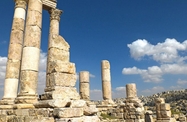Year-end tourism figures released by the Jordanian authorities suggest the sector is stabilising after a contraction across a number of indicators in 2015, with several government initiatives expected to facilitate further improvements this year.

Visitor arrivals hit 6.4m in 2016, up 33.5% on the previous year, according to the Ministry of Tourism and Antiquities (MoTA). This increase was partly driven by growth in overnight stays, which reached 3.8m for solo travellers and 314,000 for groups – increases of 19.9% and 5.7%, respectively.
In addition to welcoming more visitors, the kingdom also witnessed a more diverse visitor portfolio throughout 2016.
Arrivals from the Asia Pacific region rose by almost 19.5% over the 12-month period, followed by growth in visitor numbers from Europe (6%), Africa (5%) and the Americas (3%). However, tourists from the Gulf declined by 10%, with the MoTA partly attributing the drop to austerity measures implemented in Saudi Arabia – the biggest contributor to inbound visitors from the GCC.
This growth in visitor traffic did not, however, translate into higher sector revenue, which fell 0.6% to JD2.87bn ($4bn). While this was the second annual decrease in a row, it was much less severe than the 7.1% slowdown recorded in 2015.
Promoting domestic and religious tourism
Domestic inflows remained modest in 2016 at JD77m ($108.6m), well below outbound revenues, which totalled JD800m ($1.1bn), according to the MoTA. To address this gap, the government is working to promote tourist destinations to its own citizens.
“We seek to transfer part of the outbound revenues to domestic tourism revenues by developing touristic products at various sites across the country to encourage citizens to visit,” Lina Annab, minister of tourism and antiquities, told a press conference in mid-January.
Government efforts will also be geared toward enhancing religious tourism. While details on planned initiatives to attract more religious tourists have yet to be fleshed out fully, Annab announced at the end of November that Jordan and Egypt had signed 17 agreements concerning tourism related projects, with part of the cooperation set to include the development of religious tourism in the kingdom.
Such projects should help Jordan build on its existing historical and cultural status. Home to holy sites of importance to Muslims, Christians and Jews, Jordan has sharpened its focus on catering to pilgrims from all three faiths. Sites of interest include the UNESCO World Heritage Site of Petra, which is referred to on numerous occasions in the Old Testament, Christian and Muslim places of worship among the Roman ruins at Jerash, as well as the sixth-century mosaic map of Jerusalem and the Holy Land at Madaba.
The segment received a boost in 2016, when strong growth figures were posted at these key locations. For example, the total number of visitors to Petra, located 235 km south of Amman, reached 465,000 last year, according to government figures, up 14% on the previous year. In Jerash, 48 km north of the capital, the number rose to 211,000, marking an 18% y-o-y increase, while Madaba, situated 20 km southwest of Amman, recorded a 10% y-o-y rise in visitor numbers, with the full-year total reaching 258,500.
Critical contribution
Tourism has traditionally been a lynchpin of the kingdom’s economy – accounting for around 13% of GDP – with ongoing efforts to drive up visitor numbers expected to have a trickle-down effect on the broader economy.
According to data compiled by the World Tourism & Travel Council (WTTC), Jordan’s tourism sector directly contributed JD1.45bn ($2bn) to GDP in 2015, with a further 2.1% rise expected in 2016.
While the sector appears to have regained some of the momentum it lost in 2015, regional unrest spilled into the kingdom in December, when an attack in the southern city of Karak led to the death of at least 12 people, including one tourist. While Annab told media it was “business as usual” and that “cancellations have been minimal”, the full impact of the attack is not yet known.
Having avoided much of the insecurity that has beset its neighbours in recent years, Jordan continues to be viewed as a relatively safe destination and was ranked 58th of 130 countries in the most recent global terrorism index issued by the Institute for Economics and Peace. Maintaining this reputation looks set to be crucial in ensuring the government’s plans to expand underdeveloped segments of the industry are successful.


